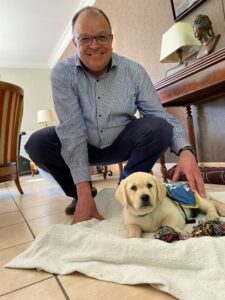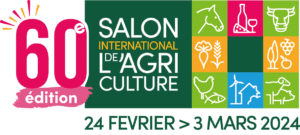Depuis le 16 mai 2022, nous avons le plaisir d’accueillir dans notre siège d’Ivry-sur-Seine (94) Taïka, une petite chienne en formation pour devenir chien guide d’aveugles.

Taïka, un chien guide d’aveugle en formation chez Grands Moulins de Paris !
Taïka est née dans le centre d’élevage CESECAH de Montsablé à Lezoux dans le Puy de Dôme. Le CESECAH (Centre d’Etude, de Sélection et d’Elevage de Chiens guides pour Aveugles et autres Handicapés) est un élevage de chiens ayant pour mission de faire naître des chiots les plus aptes possibles à leur futur métier de Chiens Guides d’aveugles. Il s’agit d’une structure unique en France, elle a été créée à la demande des écoles françaises de chiens guides.
Taîka appartient à l’Association des Chien Guides d’aveugle d’Ile de France qui assure son suivi et son éducation durant 10 ans. Cette école est basée à Coubert (77).
Taïka est aux côtés d’Éric OBSTETAR, Directeur Logistique, à l’initiative de cette démarche, après validation auprès de la CSSCT et information du CSEU, dans le cadre de notre démarche RSE et de notre politique handicap.
« Nous sommes bénévoles à l’école des chiens guides d’aveugles de Coubert depuis une dizaine d’années. Après avoir été famille de week-end, recevant pour leur détente les chiens déjà en école durant la semaine, nous avons souhaité participer directement à leur éducation en devenant famille d’accueil.
Taïka, labrador femelle de deux mois, fera partie de notre quotidien jusqu’à son entrée à l’école. Nous allons la socialiser : elle m’accompagnera certains jours au bureau, en utilisant les transports en commun, et participera aux réunions. Je lui ferai découvrir différents lieux fréquentés : le marché, les magasins, la ville. Nous lui apprendrons durant cette période quelques bases d’éducation; accompagnés par Manon, notre éducatrice canine. Taïka nous quittera vers l’âge de dix mois pour rentrer en école. »
Cette initiative est encadrée par une convention signée entre Grands Moulins de Paris et l’école de chiens guides, qui précise les modalités de prise en charge du chien au sein de l’entreprise.
Chiens guide d’aveugle : quel est leur rôle ?
Le chien guide est éduqué pour faciliter la vie quotidienne de son maître, déficient visuel, notamment dans tous ses déplacements. Il peut apprendre jusqu’à 50 ordres différents !
Contrairement aux idées reçues, le chien guide d’aveugle n’est pas réservé aux aveugles. Les personnes malvoyantes peuvent aussi y prétendre. Par son éducation et son travail de guidage, le chien va apporter à son maître :
• Autonomie dans ses déplacements : le maître n’est plus obligé d’être accompagné par une tierce personne ;
• Sécurité : le chien va contourner naturellement les différents obstacles ;
• Fluidité : les trajets deviennent plus fluides et moins fatigants ;
• Un meilleur relationnel : les gens entrent plus facilement en contact avec la personne déficiente visuelle lorsqu’elle possède un chien guide ;
• Une présence rassurante à ses côtés permettant de rompre avec la solitude au quotidien.
Chien guide d’aveugle : en savoir plus sur la formation
Les chiots restent environ de leur 2 à 10 mois au sein de leur famille d’accueil. Durant cette période, la famille doit effectuer un travail de stimulation, d’éveil, d’apprentissage et de socialisation du chiot. A partir de ses 10 mois, le chiot va rester pendant un an dans une école spécialisé pour lui apprendre tout ce qu’il devra savoir pour accompagner au mieux son futur maître.
Le petit chien devra devenir sociable avec :
• Tous les types de personnes qu’il sera amené à rencontrer dans sa vie : les enfants, les personnes âgées, etc.
• Ses congénères : il devra être totalement à l’aise et non-agressif avec les autres chiens.
• Toutes sortes d’animaux, qu’ils soient petits ou grands.
Le chiot devra être capable de s’adapter le plus facilement et le plus rapidement possible à différents types d’environnements. Cet atout majeur fera sa force en tant que futur chien guide. Il est donc indispensable de pouvoir l’emmener dans différents environnements, notamment sur son lieu de travail.
Le chien est également suivi par un vétérinaire et comportementaliste canin afin de s’assurer qu’il est en bonne santé, qu’il a le bon comportement et qu’il ait bien appris les bonnes règles. Si ce n’est pas le cas, le chien peut être « déclassé » et ne sera plus destiné à être chien guide d’aveugle.
Après son année d’école, si le chien est déclaré apte à travailler, il est prêté à une personne malvoyante jusqu’à ses 7 ans. A partir de cette âge il sera en retraite dans une autre famille, souvent un proche de son maître précédent ou de l’association.


